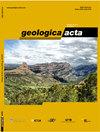C and O stable isotopes and rare earth elements in the Devonian carbonate host rock of the Pivehzhan iron deposit, NE Iran
IF 2
4区 地球科学
Q2 GEOLOGY
引用次数: 3
Abstract
The Pivehzhan iron deposit is located at about 80km southwest of Mashhad, NE Iran. They occur within the Devonian carbonates as lenticular and massive bodies, as well as veinlets of magnetite and iron sulphides, transformed to goethite and haematite by weathering process. The hydrothermal calcite is the most important gangue mineral, which is observed in the form of veins/veinlets and open-space filling. The iron ores are accompanied by some minor elements such as Mn, Ti, Cr, and V and negligible amounts of Co and Ni. The distribution pattern of Rare Earth Elements (REEs) normalized to Post Archean Australian Shale (PAAS), which is characterized by the upward convex, as well as the positive Eu anomalies indicate the activity of reduced and acidic hydrothermal fluids. The negative Ce anomalies of host carbonates, although slight, point to the dominance of anoxic conditions during interaction with hydrothermal fluids. The hydrothermal calcite and quartz coexisting with the iron minerals contain principally fluid, which were homogenized into liquid phase. The homogenization temperature (TH (L-V) ) and the salinity of the analysed fluid inclusions range from 129°C to 270°C and from 0.4wt.% to 9.41wt.% NaCl eq., respectively. The δ 13 C PDB and δ 18 O SMOW values ranges from -2.15‰ to -5.77‰ (PeeDee Belemnite standard, PDB) and from +19.87‰ to +21.64‰ (Standard Mean Ocean Water standard, SMOW) in hydrothermal calcite veinlets occurring with iron minerals and -0.66‰ to -4.37‰ (PDB) and +15.55‰ to +20.14‰ (SMOW) within the host carbonates, respectively. The field relations and petrographic examination along with geochemical and isotopic considerations indicate that the Pivehzhan iron deposit was formed through replacement processes by reducing and acid fluids containing light carbon and oxygen isotopes. Variations in the physico-chemical conditions of hydrothermal fluids and their interaction with carbonates were the most effective mechanisms in the formation of this iron deposit. The potential source of iron was probably the basement magmatic rocks from which iron was leached by hydrothermal solutions.伊朗东北部Pivehzhan铁矿泥盆系碳酸盐岩储集岩C、O稳定同位素及稀土元素特征
Pivehzhan铁矿位于伊朗东北部马什哈德西南约80公里处。它们以透镜状和块状体的形式出现在泥盆纪碳酸盐岩中,以及由风化作用转化为针铁矿和赤铁矿的磁铁矿和硫化铁细脉。热液方解石是最重要的脉石矿物,以脉/细脉和开孔充填形式存在。铁矿石中还含有少量的锰、钛、铬和钒等元素,Co和Ni的含量可忽略不计。稀土元素(ree)分布模式归一化到太古宙后澳大利亚页岩(PAAS),呈上凸特征,且Eu正异常表明还原酸性热液的活动。寄主碳酸盐的负Ce异常虽然轻微,但表明在与热液流体相互作用过程中缺氧条件占主导地位。与铁矿物共生的热液方解石和石英主要含流体,均质进入液相。分析的流体包裹体均质温度(TH (L-V))和盐度范围为129°C至270°C, 0.4wt。%至9.41吨。% NaCl eq.。与铁矿物共生的热液方方石细脉中δ 13c PDB值为-2.15‰~ -5.77‰(PeeDee belenite standard, PDB), δ 18o SMOW值为+19.87‰~ +21.64‰(standard Mean Ocean Water standard, SMOW),主碳酸盐中δ 13c PDB值为-0.66‰~ -4.37‰(PDB), δ 18o SMOW值为+15.55‰~ +20.14‰(SMOW)。野外关系、岩石学研究、地球化学和同位素研究表明,皮韦展铁矿床是由含轻碳、轻氧同位素的还原性和酸性流体置换作用形成的。热液流体物理化学条件的变化及其与碳酸盐的相互作用是该铁矿床形成的最有效机制。铁的潜在来源可能是基底岩浆岩,其中铁被热液浸出。
本文章由计算机程序翻译,如有差异,请以英文原文为准。
求助全文
约1分钟内获得全文
求助全文
来源期刊

Geologica Acta
地学-地质学
CiteScore
2.50
自引率
6.70%
发文量
13
审稿时长
>12 weeks
期刊介绍:
- Relevant conceptual developments in any area of the Earth Sciences.
- Studies presenting regional synthesis.
- Thematic issues or monographic volumes presenting the results from one or more research groups.
- Short papers reflecting interesting results or works in progress.
- Contributions and results from Research Projects, Workshops, Symposiums, Congresses and any relevant scientific activity related to Earth Sciences.
- Geologica Acta aims to stimulate rapid diffusion of results and efficient exchange of ideas between the widespread communities of Earth Science researchers (with special emphasis on Latinamerica, the Caribbean, Europe, the Mediterranean
 求助内容:
求助内容: 应助结果提醒方式:
应助结果提醒方式:


